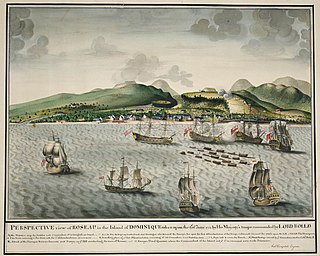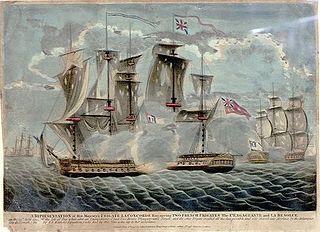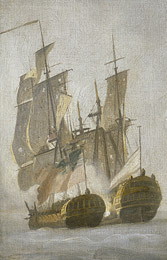
HMS Dublin was a 74-gun third rate ship of the line of the Royal Navy, built by Adam Hayes at Deptford Dockyard and launched on 6 May 1757.

HMS Essex was a 70-gun third rate built by Sir Henry Johnson of Blackwall in 1678/79. During the War of the English Succession she fought in the last major action. She was rebuilt in 1699/1700. During the War of Spanish Succession she fought at Vigo Bay, the Capture of Gibraltar and Velez Malaga. She also fought at the Battle off Passero in 1718. She was rebuilt again in 1736-40. She was in action off Toulon in 1744. She was active in the Channel and against French ports during the Seven Years War. She fought at Quiberon Bay in 1759. She was wrecked in Quiberon Bay in November 1759.

HMS Expedition was a 70-gun third-rate ship of the line built at Portsmouth Dockyard in 1677/79. She was in active commission during the War of the English Succession participating in the battles of Beachy Head and Barfleur. She was rebuilt in 1699. Again, for the War of Spanish Succession she was in commission for the operation at Cadiz then returned to England where she sat for two years. She was in the Mediterranean for the Battle of Marbella in 1705. She then went to the West Indies and fought in Wager’s action off Cartagena in 1708. She was rebuilt in 1709-14 to the 1706 Establishment. She spent her time split between the Baltic and as guard ship at Portsmouth before being broken at Portsmouth in 1736. She was rebuilt in 1736/40 at Deptford Dockyard.

HMS Deptford was a 60-gun fourth rate ship of the line of the Royal Navy, built to the dimensions of the 1719 Establishment at Deptford Dockyard, and launched on 22 August 1732.

HMS York was a 60-gun fourth rate ship of the line of the Royal Navy, built at Plymouth Dockyard to the draught specified in the 1745 Establishment, and launched on 10 November 1753. She saw active service during the Seven Years' War against France, and was responsible for the capture of seven French vessels over her ten years at sea. After extensive service in Europe, North America and the east Indies, York was decommissioned in 1765 and broken up at Plymouth in 1772.

HMS Montagu was a 60-gun fourth rate ship of the line of the Royal Navy, designed by Edward Allin and built at Sheerness Dockyard to the standard draught for 60-gun ships as specified by the 1745 Establishment, amended in 1750, and launched on 15 September 1757.
HMS Boreas was a 28-gun Coventry-class sixth-rate frigate of the Royal Navy. Built by Israel Pownoll at Woolwich Dockyard and launched in 1757, she was one of five frigates of the class built of fir rather than oak. Boreas saw service during the Seven Years' War and took part in two actions at sea. She assisted in the capture of the 36-gun French frigate Diane in April 1758, and her most famous engagement was the capture of the French frigate Sirène in October 1760. She was sold out of the service in 1770.
HMS Valeur was a 28-gun sixth-rate frigate of the Royal Navy, initially launched in 1754 as the Valeur for the French Navy, and classified by them as a corvette. The British captured her in 1759. In Royal Navy service she captured several merchant vessels and privateers before she was sold in 1764.

Concorde was a 32-gun frigate of the French Navy, lead ship of her class. Built in Rochefort in 1777, she entered service with the French early in the American War of Independence and was soon in action, capturing HMS Minerva in the West Indies. She survived almost until near the end of the war when HMS Magnificent captured her in 1783. Not immediately brought into service due to the draw-down in the navy after the end of the war, Concorde underwent repairs and returned to active service with the outbreak of war with France in 1793 as the fifth-rate HMS Concorde.
HMS Vengeance was a 28-gun sixth rate of the Royal Navy. She had previously been a French privateer under the same name until her capture in 1758 during the Seven Years' War.
HMS Aeolus was a 32-gun Amphion-class fifth-rate frigate of the Royal Navy. She was launched in 1801 and served in the French Revolutionary and Napoleonic Wars, and the War of 1812.

HMS Minerva was one of the four 32-gun Southampton-class fifth-rate frigates of the Royal Navy. She was launched in 1759 and served through the Seven Years' War, but was captured in 1778 during the American Revolutionary War and served as the French Minerve until being recaptured in 1781 and renamed HMS Recovery. She was broken up in 1784.

HMS Venus was the name ship of the 36-gun Venus-class fifth-rate frigates of the Royal Navy. She was launched in 1758 and served for more than half a century until 1809. She was reduced from 36 to 32 guns in 1792. She was sold in 1822.

HMS Brilliant was a 36-gun Venus-class fifth-rate frigate of the British Royal Navy that saw active service during the Seven Years' War with France. She performed well against the French Navy in the 1760 Battle of Bishops Court and the 1761 Battle of Cape Finisterre, but was less capable when deployed for bombardment duty off enemy ports. She also captured eight French privateers and sank two more during her six years at sea. The Royal Navy decommissioned Brilliant in 1763. The Navy sold her in 1776 and she became an East Indiaman for the British East India Company (EIC). Brilliant was wrecked in August 1782 on the Comoro Islands while transporting troops to India.

HMS Levant was a 28-gun sixth-rate frigate of the Coventry class, which saw Royal Navy service against France in the Seven Years' War, and against France, Spain and the American colonies during the American Revolutionary War. Principally a hunter of privateers, she was also designed to be a match for small French frigates, but with a broader hull and sturdier build at the expense of some speed and manoeuvrability. Launched in 1758, Levant was assigned to the Royal Navy's Jamaica station from 1759 and proved her worth by defeating nine French vessels during her first three years at sea. She was also part of the British expedition against Martinique in 1762 but played no role in the landings or subsequent defeat of French forces at Fort Royal.

HMS Aquilon was a 28-gun Coventry-class sixth-rate frigate of the Royal Navy. Launched in 1758, she saw active service against the French during the Seven Years' War, capturing seven enemy vessels in the first eight months of 1761. She was declared surplus to Navy requirements and sold into private hands in 1776.
John Carter Allen (1724–1800) was an 18th century Royal Navy commander who rose to the rank of Admiral.
HMS Winchelsea was a 20-gun sixth-rate launched in 1740 and in service during the War of the Austrian Succession in Mediterranean, Atlantic and home waters. She was captured by the French in 1758, but was retaken two weeks later. She was broken up in 1761.
HMS Tavistock was a 10-gun Royal Navy ship launched in 1745 which, despite her small size, made a disproportionate impact on navy activity of the time, certainly outstripping the reputation of her namesake HMS Tavistock (1747) in all but size. She had several very famous commanders through her service.
HMS Bideford was a 20-gun Royal Navy ship launched in 1756.










